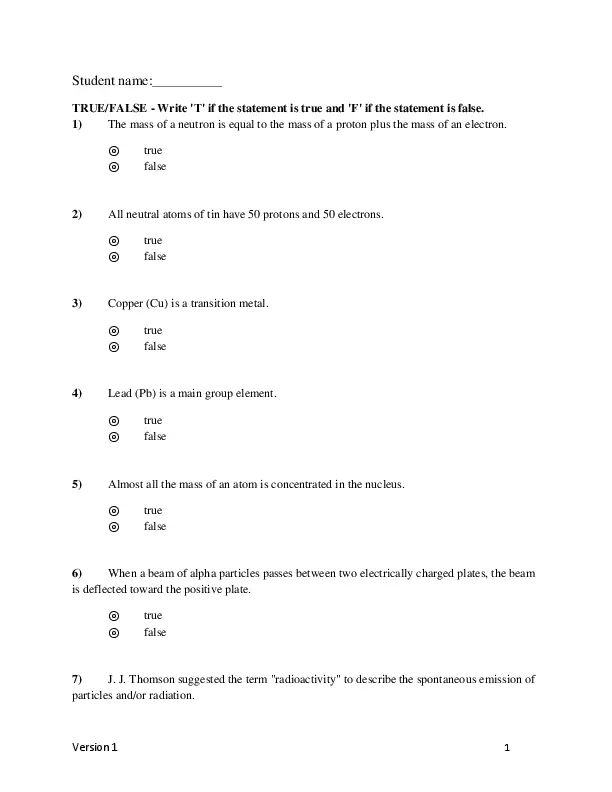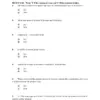Your bag is empty
Don't miss out on great deals! Start shopping or Sign in to view products added.
Shop What's New Sign inDon't miss out on great deals! Start shopping or Sign in to view products added.
Shop What's New Sign inDon't miss out on great deals! Start shopping or Sign in to view products added.
Shop What's New Sign inBromine is the only nonmetal that is a liquid at room temperature. Consider the isotope bromine-81, Select the combination which lists the correct atomic number, number of neutrons, and mass number, respectively. A) 35, 46, 81 B) 35, 81, 46 C) 81, 46, 35 D) 46, 81, 35 E) 35, 81, 116 27) Atoms X, Y, Z, and R have the following nuclear compositions: Which of the following are isotopes of the same element? A) I & II B) I & IV C) II & IV D) III & IV E) I & III 28) Which isotope is not possible? A) B) C) D) E) All of these isotopes are possible. Version 1 7 29) The principal factor that determines whether a nucleus is stable is the A) electron-to-neutron ratio. B) electron-to-proton ratio. C) neutron-to-proton ratio. D) chemical family. E) number of electrons. 30) Which of the following in not a magic number? A) 20 B) 10 C) 126 D) 82 E) 2 31) Which combination of neutrons and protons leads to the most number of stable nuclei? A) odd number of neutrons and odd number of protons B) even number of neutrons and odd number of protons C) odd number of neutrons and even number of protons D) even number of neutrons and even number of protons E) None of these options results in significantly more stable nuclei. 32) As the number of protons increases, stable nuclei will A) have an equal number of neutrons and protons. B) have an increased ratio of neutrons to protons. C) have an odd number of neutrons. D) have an decreased ratio of neutrons to protons. E) become the most common type of nuclei. Version 1 8 33) Atoms of the same element with different mass numbers are called A) ions. B) neutrons. C) chemical groups. D) chemical families. E) isotopes. 34) How many neutrons are there in an atom of lead whose mass number is 208? A) 82 B) 126 C) 208 D) 290 E) None of these choices is correct. 35) An atom of the isotope sulfur-31 consists of how many protons, neutrons, and electrons? (p = proton, n = neutron, e = electron) A) 15 p, 16 n, 15 e B) 16 p, 15 n, 16 e C) 16 p, 31 n, 16 e D) 32 p, 31 n, 32 e E) 16 p, 16 n, 15 e 36) 37. Give the number of protons (p), electrons (e), and neutrons (n) in one atom of chlorine- Version 1 9 A) 37 p, 37 e, 17 n B) 17 p, 17 e, 37 n C) 17 p, 17 e, 20 n D) 37 p, 17 e, 20 n E) 17 p, 37 e, 17 n 37) Two isotopes of an element differ only in their A) symbol. B) atomic number. C) atomic mass. D) number of protons. E) number of electrons. 38) The elements in a column of the periodic table are known as A) metalloids. B) a period. C) noble gases. D) a group. E) nonmetals. 39) Which of these materials are usually poor conductors of heat and electricity? A) metals B) metalloids C) nonmetals D) alkaline earth metals E) alkali metals 40) Which of these elements is most likely to be a good conductor of electricity? Version 1 10 A) N B) S C) He D) Cl E) Fe 41) Which of the following elements are the least reactive? A) alkali metals B) noble gases C) halogens D) alkaline earth metals E) metalloids 42) Which of the following is a nonmetal? A) lithium, Li, Z = 3 B) bromine, Br, Z = 35 C) mercury, Hg, Z = 80 D) bismuth, Bi, Z = 83 E) sodium, Na, Z = 11 43) Which of the following is a metal? A) nitrogen, N, Z = 7 B) phosphorus, P, Z = 15 C) arsenic, As, Z= 33 D) thallium, Tl, Z = 81 E) silicon, Si, Z = 14 44) Which of the following is a metalloid? Version 1 11 A) carbon, C, Z = 6 B) sulfur, S, Z = 16 C) germanium, Ge, Z = 32 D) iridium, Ir, Z = 77 E) bromine, Br, Z = 35 45) A row of the periodic table is called a(n) A) group. B) period. C) isotopic mixture. D) family. E) subshell. 46) Silicon, which makes up about 25% of Earth’s crust by mass, is used widely in the modern electronics industry. It has three naturally occurring isotopes, 28Si, 29Si, and 30Si. Calculate the atomic mass of silicon. A) 29.2252 amu B) 28.9757 amu C) 28.7260 amu D) 28.0855 amu E) 27.9801 amu 47) Lithium forms compounds which are used in dry cells, storage batteries, and in hightemperature lubricants. It has two naturally occurring isotopes, 6Li (isotopic mass = 6.015123 amu) and 7Li (isotopic mass = 7.016005 amu). Lithium has an atomic mass of 6.9412 amu. What is the percent abundance of lithium-6? Version 1 12 A) 92.53% B) 86.65% C) 49.47% D) 7.47% E) 6.015% 48) In the periodic table, atoms are arranged in order of A) increasing atomic mass. B) increasing atomic number. C) physical properties. D) periodicity. E) chemical reactivities. 49) The elements in Group 17 are known by what name? A) transition metals B) halogens C) alkali metals D) alkaline earth metals E) noble gases 50) The elements in Group 2 are known by what name? A) transition metals B) halogens C) alkali metals D) alkaline earth metals E) noble gases 51) The alkali metal elements are found in ________ of the periodic table. Version 1 13 A) group 1 B) group 2 C) group 13 D) period 7 E) period 1 52) What terms defines a mass which is exactly equal to 1/12 the mass of one carbon-12 atom? A) isotope number B) mass number C) mass-to-charge ratio D) atomic number E) atomic mass unit 53) Which of these elements is chemically similar to magnesium? A) sulfur B) calcium C) iron D) nickel E) potassium 54) Which of these elements is chemically similar to oxygen? A) sulfur B) calcium C) iron D) nickel E) potassium Version 1 14 55) Which of these elements is chemically similar to potassium? A) calcium B) arsenic C) phosphorus D) cerium E) cesium 56) How many atoms are in 0.534 mol of nickel, Ni? A) 1.13 × 10 24 atoms B) 1.48 × 10 25 atoms C) 2.44 × 10 22 atoms D) 3.22 × 10 23 atoms E) 6.98 × 10 21 atoms 57) How many atoms are in 7.12 mol of gold, Au? A) 1.18 × 10 –23 atoms B) 4.29 × 10 24 atoms C) 8.46 × 10 22 atoms D) 4.70 × 10 24 atoms E) 3.34 × 10 26 atoms 58) How many moles are in 8.73 × 10 25 atoms of boron, B? A) 145 moles B) 3.84 × 10 27 moles C) 1.45 moles D) 5.04 × 10 –25 moles E) 6.90 × 10 –3 moles Version 1 15 59) How many moles are present in 17.4 g of lead? A) 0.0994 moles B) 1.05 × 10 25 moles C) 0.0840 moles D) 10.06 moles E) 11.9 moles 60) How many grams are present in 0.885 moles of manganese? A) 62.1 g B) 48.6 g C) 21.5 g D) 27.5 g E) 0.016 g 61) Determine the mass of hydrogen (in grams) that contains 5.08 × 10 15 hydrogen atoms. A) 5.12 × 1015 g B) 3.06 × 1039 g C) 3.06 × 10–9 g D) 8.50 × 10–9 g E) 8.5 × 1015 g 62) What element is represented by X in the atomic symbol notation ? A) iridium B) platinum C) palladium D) selenium E) magnesium Version 1 16 63) A rock contains an element with a molar mass of 40.08 g/mol. If 9.28 × 10 24 atoms of this element were found in the rock, how many grams of the unknown element are present in the rock? A) 618 g B) 1.49 × 10 28 g C) 2.24 × 10 50 g D) 0.38 g E) 3.80 g 64) Five vials each contain 12 grams of a solid metal sample. The samples include calcium, platinum, barium, gold, and silver. Which vial has the most metal atoms? A) calcium B) barium C) gold D) silver E) platinum 65) Five vials each contain 12 grams of a solid metal sample. The samples include calcium, platinum, barium, gold, and silver. Which vial has the fewest moles of metal atoms? A) calcium B) barium C) gold D) silver E) platinum 66) Determine the number of electrons and identify the correct symbol for an atom with 17 protons and 18 neutrons. Version 1 17 A) B) C) D) E) 67) Determine the number of protons, electrons, and neutrons for the isotope gold-118.The symbol for gold is Au. A) 118 protons, 118 electrons, 79 neutrons B) 79 protons, 79 electrons, 118 neutrons C) 79 protons, 79 electrons, 39 neutrons D) 118 protons, 118 electrons, 39 neutrons E) 79 protons, 39 electrons, 118 neutrons 68) Determine the number of protons and identify the correct symbol for an atom with 20 neutrons and 20 electrons. A) B) C) D) E) 69) The elements in Group 18 are called the ________. Version 1 18 A) alkali metals B) alkaline earth metals C) transition metals D) halogens E) noble gases 70) The elements in Group 2 are called the ________. A) alkali metals B) alkaline earth metals C) transition metals D) halogens E) noble gases 71) The elements in Group 17 are called the ________. A) alkali metals B) alkaline earth metals C) transition metals D) halogens E) noble gases 72) The elements in Group 1 are called the ________. A) alkali metals B) alkaline earth metals C) transition metals D) halogens E) noble gases 73) Which group is given the name chalcogens? Version 1 19 A) 1 B) 2 C) 12 D) 16 E) 17 74) The table below describes four atoms. Which atoms represent the same element? A) A and B; C and D B) A and C; B and D C) A and D; B and C D) None of the these choices is correct. Version 1 20 Answer Key Test name: Atoms2 1) FALSE 2) TRUE 3) TRUE 4) TRUE 5) TRUE 6) FALSE 7) FALSE 8) B 9) B 10) B 11) C 12) A 13) B 14) E 15) A 16) B 17) C 18) D 19) A 20) E 21) C 22) D 23) C 24) D 25) B 26) A Version 1 21 27) E 28) D 29) C 30) B 31) D 32) B 33) E 34) B 35) B 36) C 37) C 38) D 39) C 40) E 41) B 42) B 43) D 44) C 45) B 46) D 47) D 48) B 49) B 50) D 51) A 52) E 53) B 54) A 55) E 56) D Version 1 22 57) B 58) A 59) C 60) B 61) D 62) B 63) A 64) A 65) C 66) A 67) C 68) B 69) E 70) B 71) D 72) A 73) D 74) C Version 1 23

$18.99 $29.99Save:$11.00(37%)
0 (0 Reviews)






Don't miss out on great deals! Start shopping or Sign in to view products added.
Shop What's New Sign in
